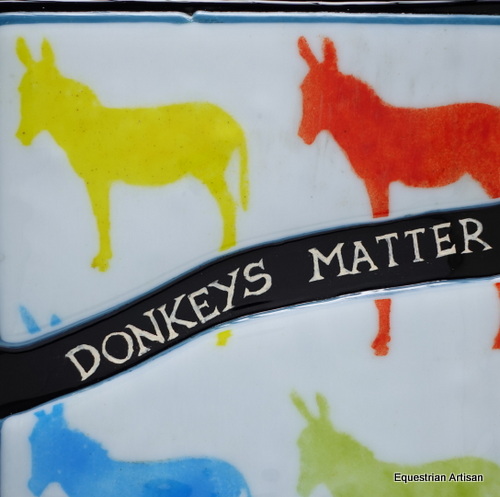Donkeys Matter Art Glass Panel – 12″ X 11″
$249.00
This glass panel is part of our Painted Work Collection of equestrian home decor. It measures 12″ x 11″.
This piece was created in response to a global crisis caused by the demand for donkey hides. “Ejiao”, a traditional Chinese medicine purported to possess healing and anti-aging properties, is made by boiling donkey hides. The huge demand for ejiao is more than China can supply, leading to the slaughter of animals in developing countries, primarily in Africa, and the export of their hides to China. It is currently estimated that over 5 million donkeys a year are being killed, some of them stolen from the families that depend on them. In my world, donkeys are adorable and affectionate animals that are wonderful companions, however in developing countries donkeys are working animals, and their economic contribution to the people who own them can make the difference between going to bed hungry or with full stomachs. To learn more about this visit: https://www.brookeusa.org/donkey-hide-crisis. Equestrian Artisan donates 20% of profits to Brooke USA to support their many projects worldwide that benefit working equines.
Creating it was a 5-step process.
Selecting the Glass: A piece of white glass was selected as the background for the image and blue glass was chosen as a backing layer.
Creating the Image: The donkeys were created using a process called “powder printing”. Finely ground glass (known as powder frit) was sifted onto the white glass using a stencil created on my laser cutter. The process was repeated four times, using different colors. After each application of frit, the stencil was repositioned and stray frit was removed. With this stage completed, the white glass was placed on top of the blue glass in preparation for fusing.
Fusing in the Kiln: The two layers were placed in a kiln and heated to 1475 degrees, the temperature at which glass melts and the layers fused together. Upon opening the kiln at the end of the firing, the panel was found to have broken into two pieces. This happens occasionally due to the expansion and contraction of glass as it changes temperature, and white glass can be particularly temperamental.
Switching to Plan B: The original plan did not include writing a message on the panel, however when repairing it I took the opportunity to do so. A piece of black glass, larger than the blue one, was cut and the two broken pieces were placed on it with space between them where the lettering was applied with white enamel paint.
2nd Firing in the Kiln: The assembly was placed in a kiln and heated again to 1475 degrees to fuse the layers.
Description
This glass panel is part of our Painted Work Collection of equestrian home decor. It measures 12″ x 11″.
This piece was created in response to a global crisis caused by the demand for donkey hides. “Ejiao”, a traditional Chinese medicine purported to possess healing and anti-aging properties, is made by boiling donkey hides. The huge demand for ejiao is more than China can supply, leading to the slaughter of animals in developing countries, primarily in Africa, and the export of their hides to China. It is currently estimated that over 5 million donkeys a year are being killed, some of them stolen from the families that depend on them. In my world, donkeys are adorable and affectionate animals that are wonderful companions, however in developing countries donkeys are working animals, and their economic contribution to the people who own them can make the difference between going to bed hungry or with full stomachs. To learn more about this visit: https://www.brookeusa.org/donkey-hide-crisis. Equestrian Artisan donates 20% of profits to Brooke USA to support their many projects worldwide that benefit working equines.
Creating it was a 5-step process.
Selecting the Glass: A piece of white glass was selected as the background for the image and blue glass was chosen as a backing layer.
Creating the Image: The donkeys were created using a process called “powder printing”. Finely ground glass (known as powder frit) was sifted onto the white glass using a stencil created on my laser cutter. The process was repeated four times, using different colors. After each application of frit, the stencil was repositioned and stray frit was removed. With this stage completed, the white glass was placed on top of the blue glass in preparation for fusing.
Fusing in the Kiln: The two layers were placed in a kiln and heated to 1475 degrees, the temperature at which glass melts and the layers fused together. Upon opening the kiln at the end of the firing, the panel was found to have broken into two pieces. This happens occasionally due to the expansion and contraction of glass as it changes temperature, and white glass can be particularly temperamental.
Switching to Plan B: The original plan did not include writing a message on the panel, however when repairing it I took the opportunity to do so. A piece of black glass, larger than the blue one, was cut and the two broken pieces were placed on it with space between them where the lettering was applied with white enamel paint.
2nd Firing in the Kiln: The assembly was placed in a kiln and heated again to 1475 degrees to fuse the layers.
Additional information
| Weight | 5.5 lbs |
|---|---|
| Dimensions | 16 × 16 × 4 in |













